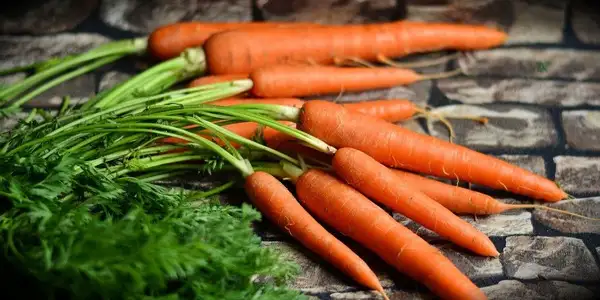
Strengthens the immune systemCarrots are rich in a number of immune system boosting vitamins and antioxidants. The most important of these is beta-carotene, an...
Read more


|
Nutrient |
Per 100 g |
|---|---|
|
Calorific value |
83 kJ |
|
Energy |
20 kcal |
|
Carbohydrates |
1 g |
|
Protein |
0 g |
|
Fat |
0 g |
The food Rhubarb (fresh) is composed of the following macronutrients.
Rhubarb has many benefits:
Rhubarb is a vegetable harvested mainly in spring and early summer. It is a popular food in Europe and North America and is often used in pies, jams, jellies, juices and soups.
Rhubarb has a tart flavor that is often combined with sugar or other sweet ingredients to make a sweet and sour mixture. It is also a good ingredient for sweet and savory dishes.
Rhubarb contains large amounts of oxalic acid, which can cause health problems in some people. Therefore, it should be consumed only in moderation.
Usually only the stalks are consumed; the leaves are poisonous and should not be eaten.
Rhubarb is readily available and can be purchased in season in supermarkets or markets. It can also be grown and is a hardy plant that thrives in most climates.
What is the shelf life of rhubarb and what is the best way to store it?
Rhubarb will keep in the refrigerator for up to a week. If it is to be kept longer, it can also be frozen.
Can rhubarb be eaten raw?
Rhubarb can be eaten raw. However, it is important to know that the rhubarb seeds and leaves are poisonous and should not be eaten. The rhubarb stalks have a sour taste that can be mellowed by cooking.
Can rhubarb be grown?
Rhubarb can be grown. It is a hardy plant that does best in colder climates. To successfully grow rhubarb, it is important to choose a suitable location with well-drained soil and to water and fertilize the plant regularly. It is also important to prune rhubarb regularly to maintain a compact and productive plant. Under the right conditions, rhubarb can be a long-lived plant that reliably bears fruit every year.
I love this app! The food is super varied and filling (and soo delicious!). With one purchase I have the ingredients for a whole week together, thanks to the shopping list. The ingredients are also readily available and not really expensive.
Nicole — App User
The first app in the field of nutrition tips that really convinces me. Updates get minor issues out of the way and new features are added all the time. Top!
Unknown user — App User
ave already tried many nutrition apps but here it is really great and you save a lot of time because you do not have to enter all the meals yourself! 👍👏
Mareen — App User
I don't usually rate apps but this one has to be rated.... I have never had such a great app just fits everything.... The nutrition plans are just absolutely awesome just everything is awesome many many thanks
Mareen — App User
This app is an excellent support for healthy eating even with little time and effort! Super recipes are also included. Highly recommended!
Lennert — App User